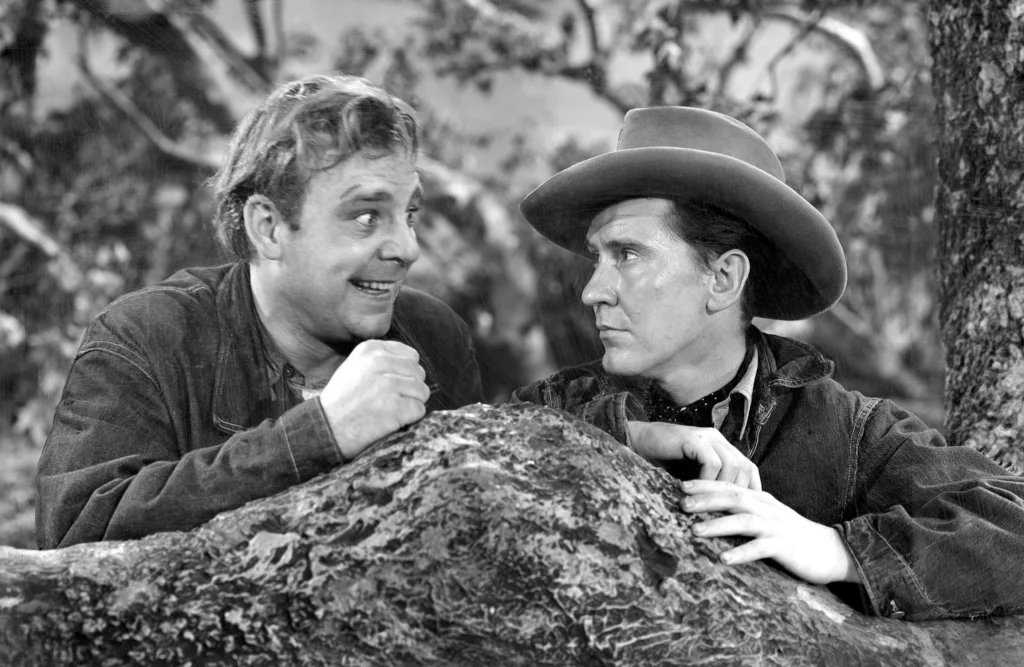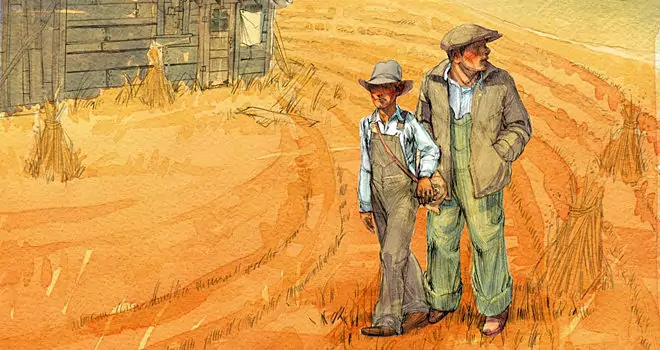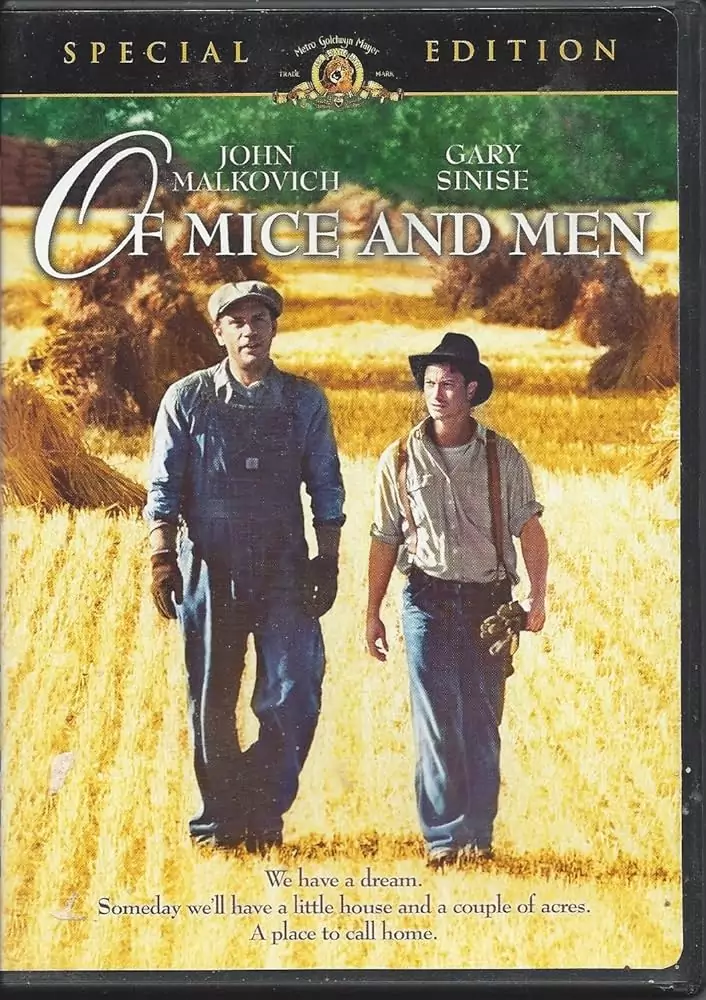The following review example can serve as a guide for students trying to find inspiration when writing a discussion piece on the Of Mice and Men theme.

✅ AI Essay Writer ✅ AI Detector ✅ Plagchecker ✅ Paraphraser
✅ Summarizer ✅ Citation Generator
John Steinbeck’s classic novella “Of Mice and Men,” set during the Great Depression, offers a poignant exploration of the human condition through the lives of its protagonists, George Milton and Lennie Small. As they navigate the harsh realities of itinerant labor in California, Steinbeck masterfully weaves a narrative rich in topics that resonate with the trials and aspirations of that era.
What is the theme Of Mice and Men? The story, while rooted in the specific historical and social context of the 1930s, transcends its setting to address not just one but universal themes of friendship, dreams, loneliness, and the struggle for personal independence. Each theme contributes to the rich tapestry of the narrative, offering insights into human nature and societal conditions of the time. This essay delves into these central topics, unraveling how they are intricately interwoven into the fabric of the novella and reflecting on their enduring relevance in contemporary society.
Aspirations: The Dream of a Better Life
Central to “Of Mice and Men” is the theme of aspirations, embodied in George and Lennie’s dream of owning their farm. This dream, detailed with lush descriptions of self-sufficiency and comfort, offers a stark contrast to their harsh reality as itinerant workers living a life of uncertainty and toil. Steinbeck uses this dream to symbolize hope and the pursuit of happiness, a fundamental human desire. The dream also serves as a bond between George and Lennie, providing them with a sense of purpose. The inclusion of Candy in this dream later in the novel and Crooks’ momentary interest in it reflect how this aspiration is universal, yet often unattainable in the face of harsh realities.
Loneliness and the Need for Companionship: Societal Barriers
Steinbeck masterfully portrays the theme of loneliness through his characters, each isolated in their own way. The setting of the ranch, a place where workers come and go, serves as a backdrop for this isolation. Crooks, as a black stable hand, experiences racial segregation, confined to his own quarters and barred from socializing with others. Curley’s wife, the only woman in the story, is desperately lonely, her identity tied to a husband who neglects her. Her attempts to interact with the ranch workers are often rebuffed or misunderstood, highlighting the societal norms that fuel her isolation. Steinbeck uses these characters to show how loneliness can be a product of societal forces as much as personal circumstances.

The State of Powerlessness: At the Mercy of Greater Forces
The theme of powerlessness is pervasive throughout the novel. The itinerant workers are depicted as being at the mercy of the economy and their employers, with little control over their lives. This is particularly evident in the character of Lennie, whose mental disability leaves him dependent on George for guidance and protection. Steinbeck uses Lennie’s character to highlight the vulnerability of those who do not fit into societal norms. The sense of powerlessness is also evident in the futility of the characters’ actions against larger forces, symbolized by the relentless cycle of their work and aspirations.
The Evil of Oppression and Abuse: Human Interaction’s Dark Side
Oppression and abuse are seen in the interactions between the characters. Curley’s aggressive nature and his abusive relationship with his wife are prime examples. Steinbeck also explores the theme through the character of Crooks, who faces racial abuse and is often the target of the other men’s cruelty. The author uses these instances to comment on the broader societal evils of oppression, where those in positions of power exploit and mistreat the vulnerable.
Fate: The Inevitability of Certain Outcomes
Fate is a significant theme in “Of Mice and Men.” The novel’s tragic ending, where George is compelled to kill Lennie, is a poignant commentary on the inevitability of certain outcomes. Steinbeck seems to suggest that despite their efforts to change their situation, the characters are bound by fate. The dream that George and Lennie share appears doomed from the start, given the realities of their world. This sense of inevitability is a stark reminder of the limitations imposed by societal conditions and personal circumstances.
The Role of Inherent Limitations and Circumstances: Shaping Destinies
The novel explores how inherent limitations and external circumstances shape the characters’ destinies. Lennie’s intellectual disability and George’s commitment to taking care of him dictate much of their lives. The Great Depression served as a crucial backdrop, creating a landscape of scarcity and despair. This environment limits the characters’ opportunities, influencing their decisions and interactions. Steinbeck uses these limitations to highlight the struggles faced by individuals in such trying times.
Animals: Symbolism and Foreshadowing
Animals in “Of Mice and Men” are used symbolically to reinforce the novel’s themes. Lennie’s affection for soft animals, which he often accidentally kills, symbolizes the tragic consequences of his unawareness of his own strength. The death of Candy’s dog is a significant moment in the novel, as it foreshadows the story’s tragic ending and serves as a metaphor for the fate of those who are no longer deemed useful in society. These animal motifs contribute to Steinbeck’s exploration of vulnerability and the harsh realities of life.
Summary

“Of Mice and Men” is a multi-layered narrative that delves into the human condition through its exploration of various themes. Steinbeck’s portrayal of Of Mice an Men themes such as aspirations, loneliness, powerlessness, oppression, fate, inherent limitations, and the symbolism of animals create a vivid picture of life during the Great Depression. Each theme is intricately interwoven into the fabric of the story, making the novel a rich and enduring piece of literature that continues to resonate with readers today.
Follow us on Reddit for more insights and updates.







Comments (0)
Welcome to A*Help comments!
We’re all about debate and discussion at A*Help.
We value the diverse opinions of users, so you may find points of view that you don’t agree with. And that’s cool. However, there are certain things we’re not OK with: attempts to manipulate our data in any way, for example, or the posting of discriminative, offensive, hateful, or disparaging material.